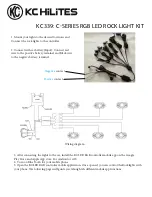
2. Weigh your vehicle without cargo. To obtain correct weights, take your
vehicle to a shipping company or an inspection station for trucks.
3. Subtract your loaded weight from the maximum GCWR in the chart.
This is the maximum trailer weight your vehicle can tow. It must be
below the maximum trailer weight shown in the chart.
TRAILER TOWING
Trailer towing with your vehicle may require the use of a trailer tow
option package.
Trailer towing puts additional loads on your vehicle’s engine,
transmission, axle, brakes, tires, and suspension. For your safety and to
maximize vehicle performance, be sure to use the proper equipment
while towing.
Follow these guidelines to ensure safe towing procedure:
•
Do not tow a trailer until your vehicle has been driven at least
1,000 miles (1,600 km).
•
Stay within your vehicle’s load limits.
•
Thoroughly prepare your vehicle for towing. Refer to
Preparing to
tow
in this chapter.
•
Use extra caution when driving while trailer towing. Refer to
Driving
while you tow
in this chapter.
•
Service your vehicle more frequently if you tow a trailer. Refer to the
severe duty schedule in the scheduled maintenance guide.
•
Refer to the instructions included with towing accessories for the
proper installation and adjustment specifications.
Do not exceed the maximum loads listed on the Safety Compliance
Certification label. For load specification terms found on the label, refer
to
Vehicle loading
in this chapter when figuring the total weight of your
vehicle.
Your vehicle is equipped with a standard Class II integrated hitch and
requires only a draw bar and ball with a 3/4 inch (19 mm) shank
diameter. An optional Class III/Class IV hitch is also available.
Note:
Do not exceed the GVWR or the GAWR specified on the Safety
Compliance Certification Label.
2009 Mountaineer
(mnt)
Owners Guide, 2nd Printing
USA
(fus)
Tires, Wheels and Loading
254
















































